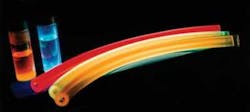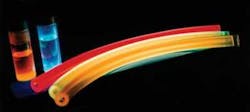Semiconducting dendrimers promise advances in cheap plastic lasers
Physicists at the University of St. Andrews (St. Andrews, Scotland) have fabricated a new class of semiconducting dendrimer that combines the optoelectronic properties of semiconductors with the fabrication ease of polymers to create novel light-emitting devices. Dendrimers are polymer macromolecules with numerous branches that can be independently tuned to optimize different optical, electronic, and processing properties.
Graham Turnbull, Ifor Samuel, and colleagues fabricated optically pumped distributed-feedback lasers in less than two minutes using a lithographic technique called solvent-assisted micromolding to form patterned dendrimer thin films 100 to 220 nm thick. When the dendrimer films are optically pumped with an ultraviolet microchip laser, they fluoresce at wavelengths between 408 and 431 nm, depending on the film thickness. The best devices demonstrated a lasing threshold of 4.5 μJ/cm2 and slope efficiency of 8.3%. The plastic material can be formed into unusual shapes, and fluoresce in different colors. Turnbull presented the experimental results at SPIE’s Optics + Photonics conference (Aug. 26-30; San Diego, CA). “The simple fabrication, visible energy gaps, and scope for tuning would make these lasers interesting for spectroscopy and point-of-care medical diagnostics,” says Samuel. Contact Ifor Samuel at [email protected]. (Photo courtesy of Jonathan P. J. Markham) (For more on Optics + Photonics, see “Optics + Photonics sees nano and solar future,” p. 40).

